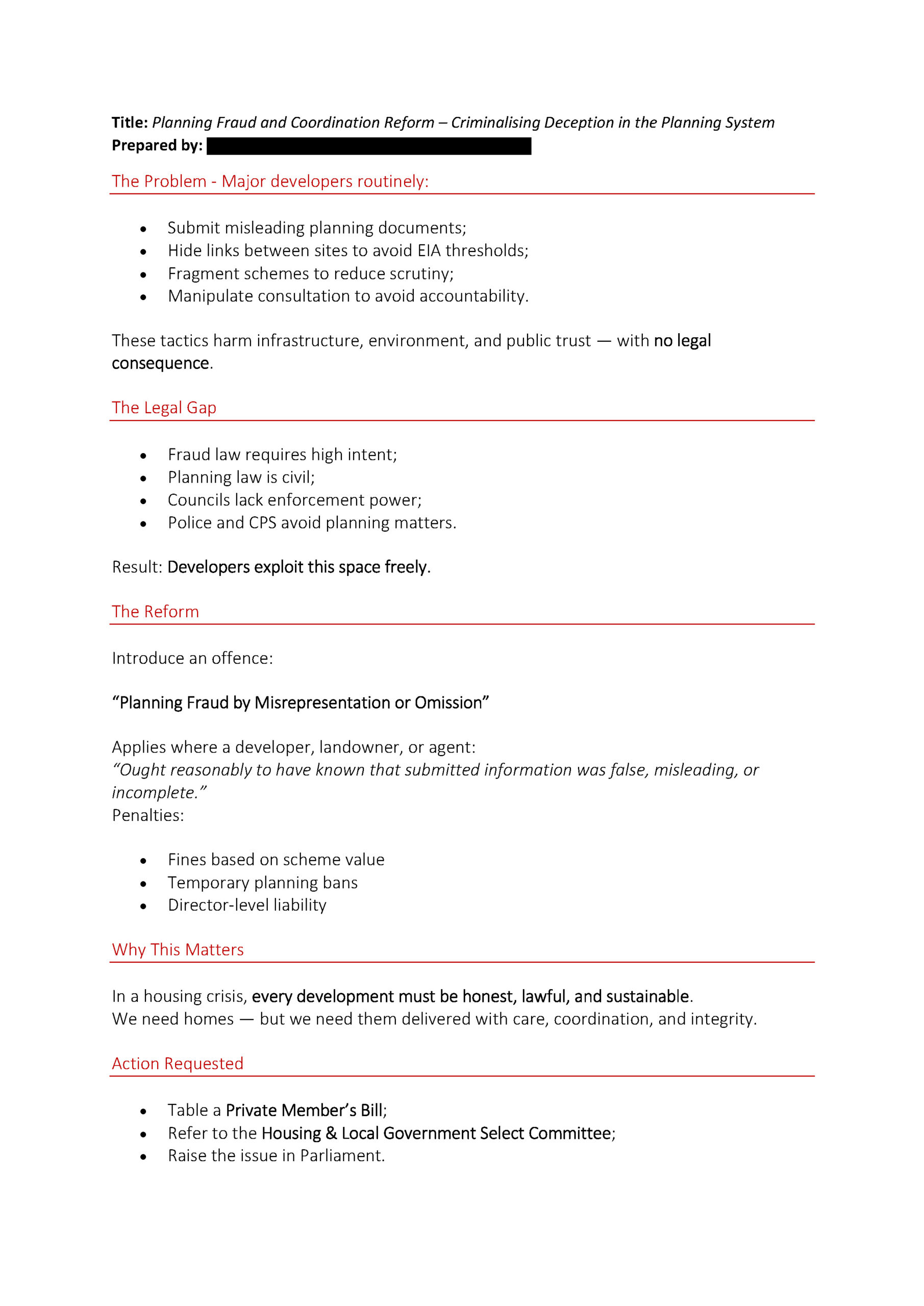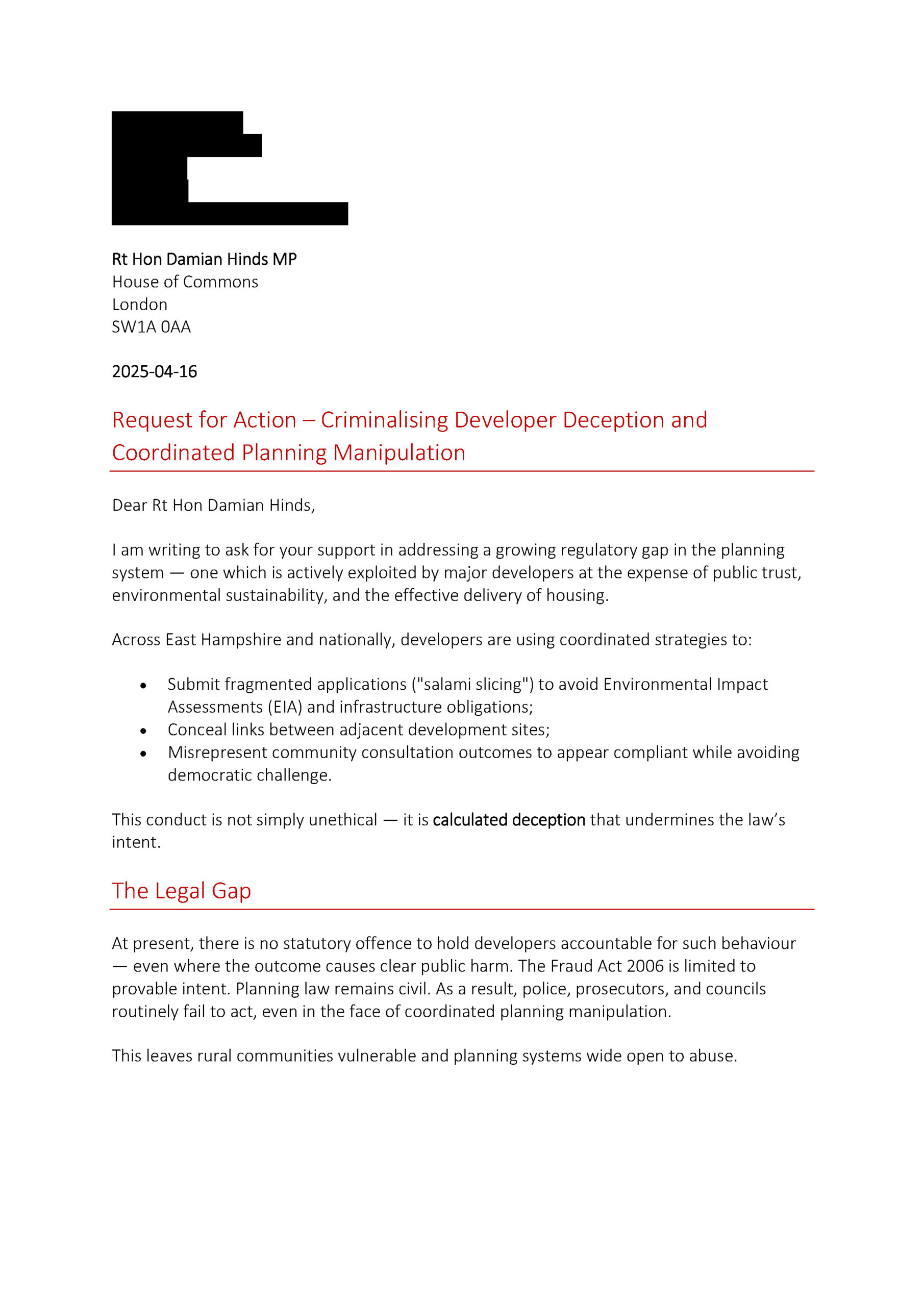Once more, Nick’s creative modus operandi was brought upon us, and yea, the balance was tilted. Creativity is a fine mindset — essential, even — if you’re a fashion designer. But if it’s your foundation in accountancy, you’d be done for it. Apply with caution — if you’re a public servant!
In a recent letter from Nick Upton, Development Manager at EHDC, we see either a profound misunderstanding of how the EIA1 Regulations apply — or something more deliberate. He writes:
“The government does not see EIA regulations as a barrier to growth and that they will only be triggered for a small proportion of very large-scale proposals that have potential impacts outside the area they are located in, such as power stations, major urban extensions, airports for example.”
This conveniently omits any reference to residential development and ignores how the significance of environmental effects must be judged relative to the settlement type — i.e. village versus town or city. It also skips over the requirement to consider cumulative impact, explicitly required by Schedule 3 of the 2017 EIA Regulations.
While it’s true the government doesn’t intend EIA to be a barrier to growth, it is also true — and far more relevant — that the government requires EIA screening by law. That part, Mr Upton does not mention.
Instead, he offers a line designed to mislead:
“The fact that a formal EIA is not required does not mean the applicant does not need to submit environmental information… This was the case with the Beechlands Road scheme.”
This is meant to imply that because “some environmental information” was submitted, no formal EIA screening was necessary — when in fact, the law is clear: the presence of environmental information does not override the mandatory requirement for a lawful, up-to-date EIA screening opinion.
It’s not just misleading. It’s legally irrelevant — and procedurally flawed.
Mr Upton carries on with his gospel:
“You mention that the developer has fragmented the site to avoid the mandatory Environmental Impact Assessment regulations (EIA). Whilst you’ve not provided any evidence of this, in any case, the EIA regulations do allow for a consideration of cumulative developments if and when any future proposal comes forward.”
That statement is deeply problematic — both legally and logically.
By suggesting that cumulative impact can be assessed “if and when any future proposal comes forward,” Mr Upton engages in a classic deferral fallacy. But Schedule 3, Paragraph 1(b) of the EIA Regulations 2017 is explicit:
“The cumulation with other existing and/or approved development.”
This clearly includes existing and reasonably foreseeable phases, especially:
Delaying cumulative assessment until “next time” defeats the entire purpose of EIA screening, which is to detect and prevent significant environmental harm before permission is granted.
Mr Upton also implies it is my job as a resident to prove the developer is salami-slicing — but that is not how the law works.
Under Schedule 3(1)(b) of the EIA Regulations 2017, and reinforced in case law (R (Burridge) v Breckland DC [2013]), it is the LPA’s legal duty to:
- Identify potential site fragmentation, and
- Assess cumulative impacts from related developments
It is not the role of a resident to prove this has occurred. The responsibility lies squarely with the decision-maker — in this case, EHDC.
And then the mind-blowing connection struck me:
Mr Nick Upton himself was the case officer who issued the EIA screening opinion for the original 2014 application — a proposal for 144 dwellings on 4 hectares of land by Foreman Homes. That development, in scale and intensity, was more appropriate for a town, not a rural village like Medstead, and clearly posed a risk of significant environmental harm.
And now? It just so happens that Mr Upton is also the supervising officer overseeing the Bargate Homes Phase 2 expansion — a continuation of large-scale development to the south of Medstead — and once again, no new EIA screening opinion has been issued.
Conveniently, he appears to have:
- Ignored the legal requirement that EIA screening opinions are non-transferable between applicants
- Failed to apply the updated 2017 EIA Regulations, which clearly state that EIA screening opinions are only valid for three years
- Completely overlooked the obligation to consider cumulative impact, even as Medstead experienced a 48.14% population increase from 2011 to 2021
- Dismissed the significance of the proposal simply because the current scheme is for 62 dwellings, compared to 144 in 2014 — as though scale alone determines significance, rather than context
To be clear: Medstead makes up just 1.76% of East Hampshire’s population, yet it absorbed 8.36% of all new housing in the district from 2011 to 2021. That level of disproportionate growth alone should have triggered an up-to-date, cumulative environmental screening.
⚠️ What is most outrageous?
Planning committee members are not legal officers — they rely on the professional advice of planning officers to ensure their decisions are lawful. And yet:
- No reference to Schedule 3 criteria was provided
- The committee was led to believe that the 2017 EIA Regulations have somehow reduced screening obligations
- The absence of a valid screening opinion was never disclosed
This amounts to a misrepresentation of the legal position and likely misdirection of elected members on a matter of material legal consequence.
This constitutes a procedural error and presents a clear ground for Judicial Review, based on misdirection and unlawful avoidance of EIA screening duties.


















